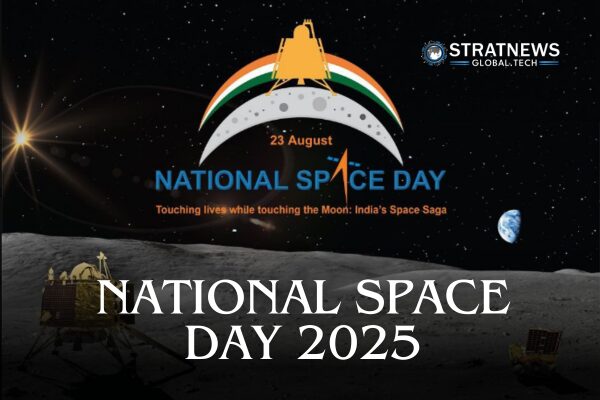India celebrated its Second National Space Day at Bharat Mandapam, New Delhi, with a gathering of scientists, students, industry leaders, and space enthusiasts, marking two years since the historic soft landing of Chandrayaan-3 on the Moon’s south pole.
Under the theme “Aryabhatta to Gaganyaan: Ancient Wisdom to Infinite Possibilities,” the celebration paid tribute to India’s enduring space legacy while unveiling bold new frontiers for its cosmic ambitions.
In a video message, Prime Minister Narendra Modi extended heartfelt greetings to scientists, professionals, and the youth of India, underscoring the transformational impact of space-tech on governance and national development.
“India is rapidly advancing in breakthrough technologies like semi-cryogenic engines and electric propulsion,” he said. “Soon, we will launch the Gaganyaan mission and, in the near future, India will build its own space station. The space sector is not only expanding but also making the lives of ordinary citizens easier—whether through satellite-based crop insurance, disaster management, or connectivity.”
He highlighted that space science has now become a central pillar of India’s national progress and youth aspiration:
“In just a short time, National Space Day has become an occasion of enthusiasm and attraction among the youth. In the past 11 years, we have implemented key reforms that have opened the space sector to innovation and inclusivity.”
From Policy to Practice: Building for Viksit Bharat 2047
The day began with National Meet 2.0 – Leveraging Space Technology for Viksit Bharat 2047, that brought together government officials, scientists, entrepreneurs, and academics to chart India’s space technology roadmap.
ISRO Chairman Dr. V. Narayanan, NITI Aayog member Dr. V.K. Saraswat, and IN-SPACe Chairman Dr. Pawan Goenka were present at the event, which included the unveiling of an expansive exhibition featuring cutting-edge technologies from startups, research institutions, and government agencies.
Breakout sessions explored space applications in agriculture, disaster resilience, health, education, urban infrastructure, and coastal management, highlighting the sector’s real-world impact. Panelists highlighted the role of space in achieving sustainable, inclusive growth across all regions of India.
Youth at the Center of India’s Space Future
Students remained at the heart of the celebration. From engaging exhibitions to direct interactions with astronaut candidates like Group Captain Shubanshu Shukla, young attendees experienced first-hand the possibilities of careers in space science and engineering.
“National Space Day is not just a celebration, it’s a commitment to shaping the next frontier,” said Dr. Subba Rao Pavuluri, President of SIA-India and CMD of Ananth Technologies. “Our youth are central to achieving India’s vision of a $44 billion space economy by 2033.”
SIA-India’s Space Kalpana contest and Young Fellowship Programme were spotlighted, celebrating the creativity of school students nationwide. Winners of the Robotics Challenge and Bharatiya Antariksh Hackathon were also honoured, showcasing the vibrant talent pipeline powering India’s future missions.
Private Sector Pioneers
India’s growing private space ecosystem was showcased, with over 300 startups participating. Companies like Thazhal Geospatial Analytics, Suhora Technologies, and MistEO presented downstream innovations in agriculture, satellite imagery, and public sector applications.
“Downstream capabilities are the bridge between exploration and national progress,” said Krishanu Acharya, CEO of Suhora Technologies. “We’re focused on converting satellite data into solutions that impact lives at scale—from agriculture and infrastructure to disaster preparedness.”
Lt. Gen. AK Bhatt (Retd.), Director General of the Indian Space Association (ISpA), noted that investor confidence is on the rise, with Indian space startups attracting over $526 million in funding to date.
“With strategic support from the government and a visionary push from the Prime Minister, India’s private space sector is driving the NewSpace revolution,” Bhatt said. “We’re seeing cutting-edge innovation in launch vehicles, satellites, and applications that position India as a global space leader.”
India’s Cosmic Blueprint
A roundtable of India’s top space officials, including ISRO Chairman Dr. V. Narayanan and Department of Space Secretary P.K. Das, laid out a bold five-year vision:
- Tripling the satellite fleet from 55 to 150 by 2028
- Launching the first module of the Bharatiya Antariksh Station (BAS) in 2028
- Executing the Gaganyaan human spaceflight mission by 2027
- Developing a 40-storey rocket capable of lifting 75,000 kg payloads—one of the world’s most powerful launch vehicles
Mission ShakthiSAT and Inclusive Global Impact
A major highlight was the announcement of Mission ShakthiSAT, a landmark educational initiative training 12,000 girls from 108 countries in space science. The mission will culminate in the launch of the ShakthiSAT aboard Chandrayaan-4 in 2026, establishing India as a global leader in space-based education and gender empowerment.
New Institutions, New Frontiers
At Vignan’s Foundation for Science, Technology & Research in Andhra Pradesh, National Space Day also witnessed the launch of the AP SpaceTech Academy (APSA)—India’s first state-level space innovation hub.
“We’re cultivating a strong space culture among youth, particularly from the Telugu-speaking scientific community,” said Dr. Pavuluri Subba Rao, APSA President-Elect. “This academy will be a global center of excellence, fostering innovation and building bridges between academia, industry, and government.”
Looking to the Stars, Grounded in Progress
“With 1.4 million STEM students entering the workforce annually,” said Anil Prakash, Director General of SIA-India, “India’s youth are the true propulsion system of our space economy.”


